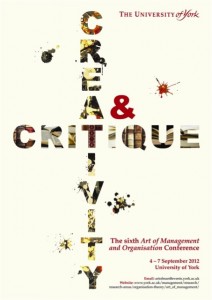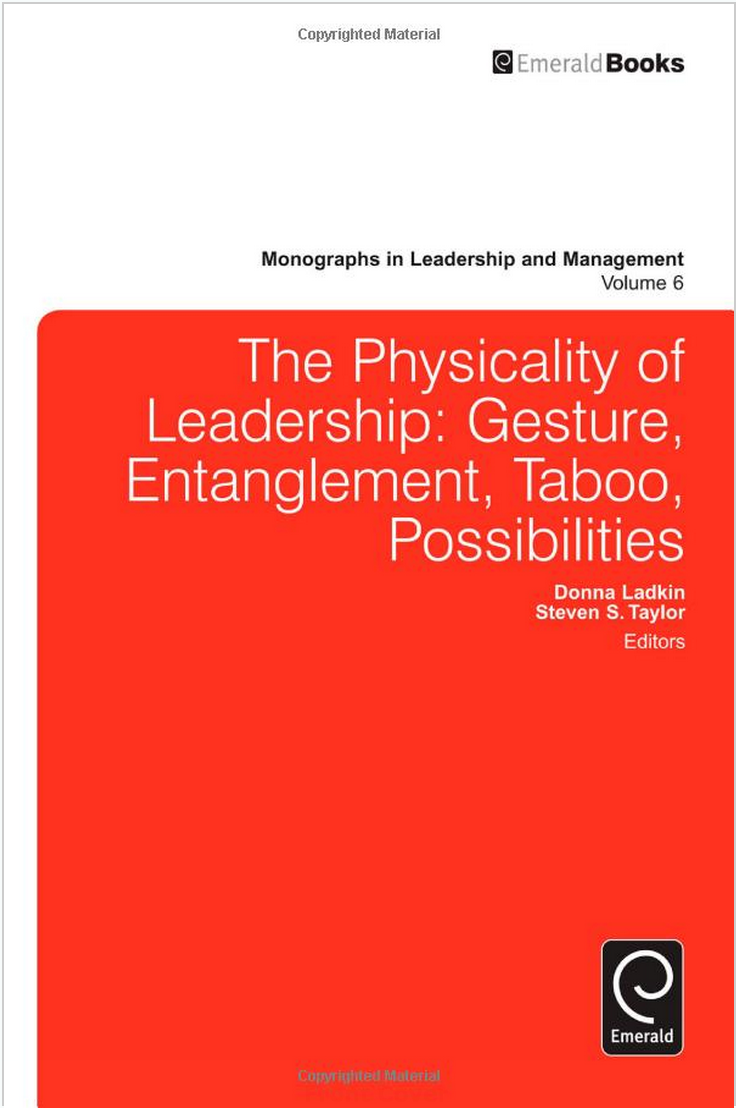I presented this paper at the Art of Management and Organization Conference in York, UK. It argues that the main bulk of literature on art-based methods in management education is based on an outdated view of cognition. To understand art-based methods better, we need to explore them from the so-called embodied view of cognition.

Introduction
Within the last 10-15 years, art-creation and art-appreciation processes have been used more extensively in management education (Nissley, 2002a, 2002b; Taylor & Ladkin, 2009) to facilitate the development of leaders’ knowledge about phenomena, such as, leadership (Wicks & Rippin, 2010), service (Bathurst, Sayers, & Monin, 2008), and visioning, improvisation, reflection, and inclusion (Cowan, 2007). Such methods have often been understood through theoretical frameworks, such as, reflection (e.g. Cowan, 2007; James, 2007), critical reflection (e.g. Barbera, 2009; Beirne & Knight, 2007), and transformative learning (Kerr & Lloyd, 2008a).
All of these theoretical frameworks make (often implicit) assumptions about what knowledge is and how cognition operates. However, in cognitive science we find (at least) three qualitatively different views of knowledge, namely, the classical/symbolic, the connectionist, and the embodied/embedded views (Lord & Shondrick, 2011; Wheeler, 2005). The goal of this paper is two-fold. First, I will create a map, indicating what each view of knowledge may contribute to our understanding of art-based methods in manager education. Second, I will look at what new research questions the embodied/embedded view might suggest in relation to art-based methods in management education.
The literature on art-based methods in management education presents a number of claimed effects of such methods (Springborg, 2012). I will look at four of the main effects art-based methods are claimed to have, from the perspectives of the symbolic, connectionist, and embodied view of knowledge. This will show how theoretical frameworks based on the embodied view of knowledge, in addition to the symbolic and the connectionist views, are necessary to understand important aspects of observed effects of art-based methods in management education.
Frameworks based on the embodied view of knowledge are not foreign to the field of art-based methods in management education. For example, some studies refer to theoretical work of John Dewey, Susan Langer, and Rudolf Arnheim concerned with art-creation and art-appreciation processes in general, the work of Elliot Eisner concerned with art in education, and the work of John Heron concerned with the interplay of various types of knowledge. All of these theoretical frameworks contain important elements of the embodied view of knowledge. However, none of them directly includes more recent developments in cognitive science and neuroscience from which the embodied view of knowledge has been elaborated substantially (and to which the term ‘embodied view of knowledge’ belongs). I, therefore, suggest the use of newer frameworks of embodied cognition, e.g., Perceptual Symbol System Theory (Barsalou, 1999, 2008), for future research in the field of art-based methods in management education. Using such a framework is especially important to more fully understand the role of perception beyond that of a more or less accurate input for cognitive processes – as suggested by the symbolic and the connectionist views. For example, it would suggest that in order for managers to be able to distinguish between closely related phenomena (e.g. states of stress and states of excitement) he/she would have to learn to simulate these states in his/her sensory-motor centres in the brain – not merely learn language based definitions of the two phenomena.
References
Barbera, L. E. (2009). Palpable pedagogy: Expressive art, leadership, and change in social justice teacher education. Disertation, Antioch. Antioch.
Barsalou, L. W. (1999). Perceptual symbol systems. The Behavioral and brain sciences, 22(4), 577–660.
Barsalou, L. W. (2008). Grounded cognition. Annual review of psychology, 59, 617–45.
Bathurst, R., Sayers, J., & Monin, J. (2008). Finding beauty in the banal : An exploration of service work in the artful classroom. Journal of management & Organization, 14(5), 521–534.
Beirne, M., & Knight, S. (2007). From Community Theatre to Critical Management Studies: A dramatic contribution to reflective learning? Management Learning, 38(5), 591–611.
Cowan, D. A. (2007). Artistic Undertones of Humanistic Leadership Education. Journal of Management Education, 31(2), 156–180.
James, A. (2007). Reflection revisited: perceptions of reflective practice in fashion learning and teaching. Art, Design & Communication in higher education, 5(3), 1–29.
Kerr, C., & Lloyd, C. (2008). Pedagogical learnings for management education : Developing creativity and innovation. Journal of Management & Organization, 14(5), 486–503.
Lord, R. G., & Shondrick, S. J. (2011). Leadership and knowledge: Symbolic, connectionist, and embodied perspectives. The Leadership Quarterly, 22, 207–222.
Nissley, N. (2002a). Art-based learning in management education. In C. Wankel & R. DeFillippi (Eds.), Rethinking Management Education for the 21st Century: Research in Management Education and Development (pp. 27–61). New York: Information Age Publishing.
Nissley, N. (2002b). Paint by numbers:: aesthetic epistemology and arts-based learning in management education.
Springborg, C. (2012). Perceptual refinement: Art-based methods in managerial education. Organizational Aesthetics, 1(1), 116–137.
Taylor, S. S., & Ladkin, D. (2009). Understanding Arts-Based Methods in Managerial Development. Academy of management Learning & Education, 8(1), 55– 69.
Wheeler, M. (2005). Reconstructing the cognitive world: The next step. Cambridge, MA: The MIT Press.
Wicks, P. G., & Rippin, A. (2010). Art as experience: An inquiry into art and leadership using dolls and doll-making. Leadership, 6(3), 259–278.


